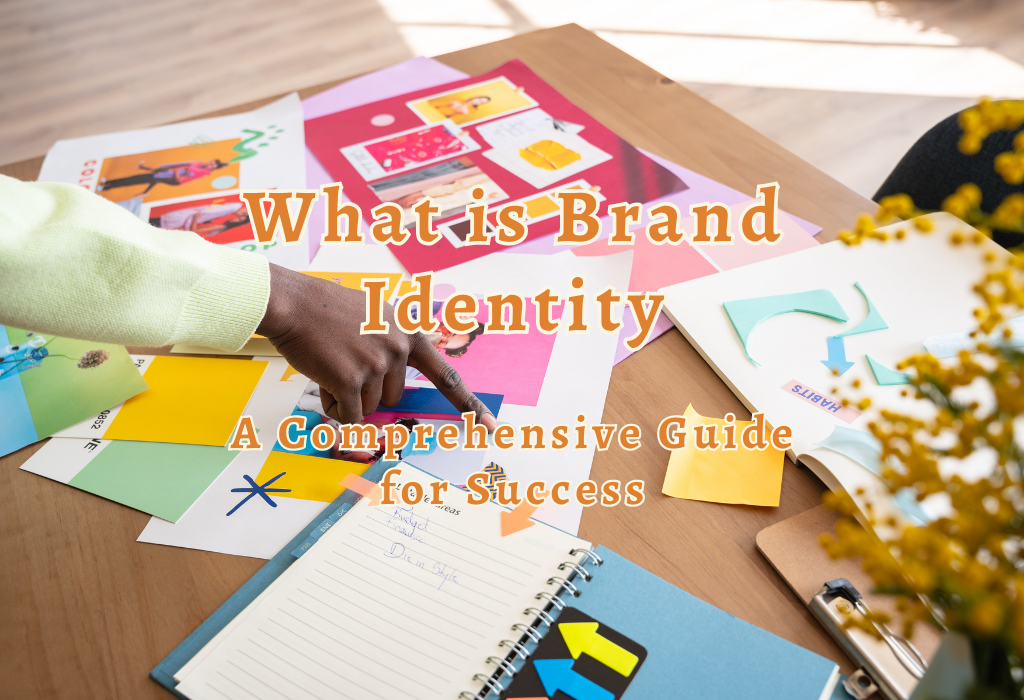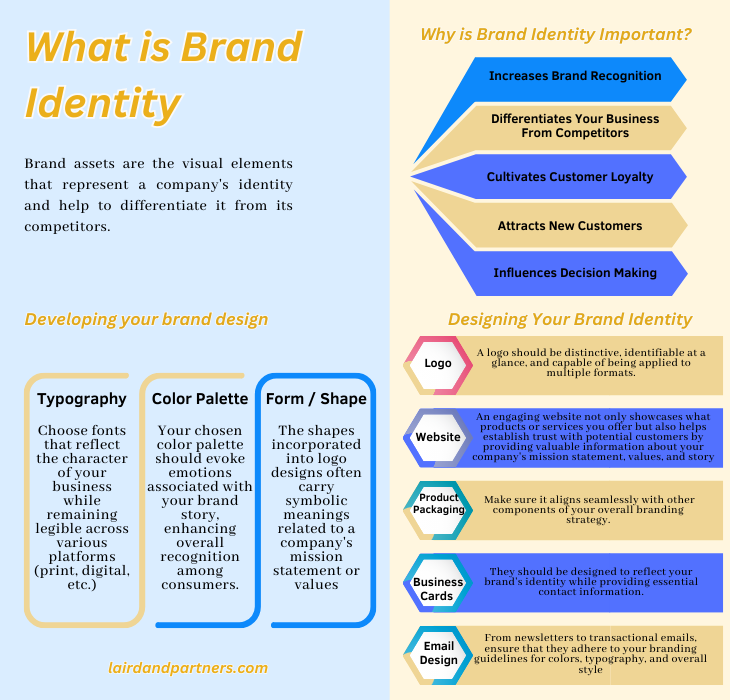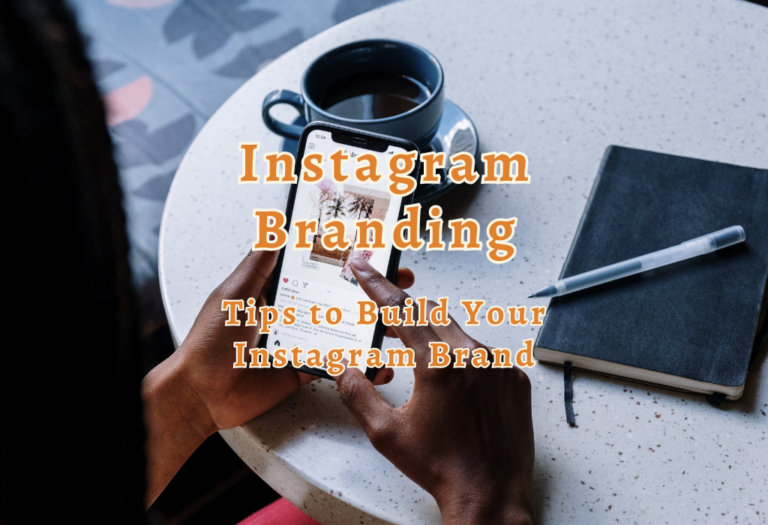What is Brand Identity: A Comprehensive Guide for Success
Brand identity is the visual representation of a brand, encompassing various elements such as its logo, colors, typography, and other design aspects that contribute to its overall look and feel.

More Resources :
The Elements of Brand Identity
A logo serves as the face of your company and is often the first thing people notice about your brand. An effective logo should be unique, memorable, and representative of your business values.
The color palette you choose for your brand can evoke specific emotions or associations in consumers’ minds. For example, red may convey passion or excitement while blue might suggest trustworthiness or stability. Selecting appropriate colors helps create consistency across all branding materials.
Typography refers to the fonts used in your branding materials. Different font styles can communicate different messages – serif fonts are generally seen as more traditional while sans-serif fonts tend to appear modern or minimalist.
Your website layout, product packaging, email templates also play significant roles in creating a cohesive visual identity for your brand.
A well-designed brand identity not only makes it easier for customers to identify with your products but also helps establish strong connections between them and their experiences with those products – ultimately leading to increased loyalty towards what you offer on marketplaces like Amazon.
Why is Brand Identity Important?

A strong brand identity plays a crucial role in the success of any business, as it helps companies stand out from their competitors and build trust with their customers. By creating an emotional connection between the customer and the brand, businesses can foster increased loyalty and drive sales.
Increases Brand Recognition
Your brand image should be instantly recognizable to consumers. A memorable logo, consistent use of colors, and typography across all marketing materials contribute to building brand recognition. When customers can identify your brand quickly amongst others, they are more likely to pick it over the rest.
Differentiates Your Business From Competitors
To stand out from other businesses in the industry, developing a distinct brand identity is essential to showcase your company’s unique features and core values. A unique and well-designed brand identity sets you apart from rivals by showcasing what makes your company special while also highlighting its core values.
Cultivates Customer Loyalty
Attracts New Customers
A strong brand identity not only helps retain existing customers but also attracts new ones. By creating a compelling brand story, you can connect with potential clients on an emotional level, making them more likely to choose your business over competitors.
Influences Decision Making
Your branding plays a significant role in influencing customer decision-making processes. When faced with multiple options, consumers tend to opt for brands they recognize and trust. Therefore, investing time and resources into developing a robust brand identity will pay off by driving consumer preference towards your products or services.
Brand identity is important because it helps to differentiate your business from competitors and create a memorable impression on customers. It also allows you to communicate the values, mission, and vision of your company in an effective way. Developing a strong brand design will help ensure that these messages are communicated clearly and effectively across all platforms!
Creating a Memorable Brand Story
A strong brand identity goes beyond just visuals; it also encompasses the story you tell about your company. Your brand story should be authentic, engaging, and resonate with your target audience. Your business’s past, purpose, principles and prospects can all be part of the narrative which builds an emotional bond between customers and your brand.
Brand identity is a distinctive combination of visuals and words that set it apart from other brands, establishing an emotional bond with consumers.
Developing your brand design
Before you start creating your design assets, you need to begin from the ground up and lock in the basics of your design structure: the building blocks of your brand identity. These foundational elements will ensure that all aspects of your branding are cohesive and consistent, helping to create a strong brand identity that resonates with customers.
a. Typography
The typeface(s) used in your branding play a crucial role in conveying your brand’s personality and values. Choose fonts that reflect the character of your business while remaining legible across various platforms (print, digital, etc.).
When selecting typefaces, factor in style (serif or sans-serif), weight (bold or light), and size for both headlines and body text to ensure legibility across all platforms.
b. Color Palette
Your chosen color palette should evoke emotions associated with your brand story, enhancing overall recognition among consumers. Colors can significantly impact how people perceive a company; therefore, it is essential to select hues that align with what you want customers to associate with when they think about your brand – be it trustworthiness, creativity, or sophistication.
c. Form / Shape
The shapes incorporated into logo designs often carry symbolic meanings related to a company’s mission statement or values. For instance, circular shapes may represent unity or wholeness, while angular forms can convey stability and strength. When designing your brand identity elements, consider the messages you want to communicate through form and shape.
By carefully selecting these building blocks of design – typography, color palette, and form/shape – you will lay a solid foundation for creating a memorable visual representation that resonates with customers and sets your business apart from competitors in the marketplace.
Designing Your Brand Identity
Creating a lasting impression on your target audience requires a powerful brand identity. To ensure that your target audience remembers and associates with your brand, you should collaborate with a designer to create visual assets which effectively communicate the values of your company. In this section, we will discuss the common elements of brand identity and how they should work together to create a cohesive look that reflects the values of your company.
Logo
Your logo is arguably the most important aspect of your brand identity as it serves as the visual representation of your business. A logo should be distinctive, identifiable at a glance, and capable of being applied to multiple formats.
Website
An engaging website not only showcases what products or services you offer but also helps establish trust with potential customers by providing valuable information about your company’s mission statement, values, and story. Ensure that all aspects of web design – from typography selection to color palette – are consistent with other branding elements for maximum impact.
Product Packaging
Product packaging, whether physical or digital (such as app icons), plays an essential role in communicating key messages about product quality while attracting attention on store shelves or online marketplaces. Make sure it aligns seamlessly with other components of your overall branding strategy.
Business Cards & Stationery Items
Despite the digital age, business cards and stationery items like letterheads or envelopes are still relevant in making a strong first impression. They should be designed to reflect your brand’s identity while providing essential contact information.
Email Design
Email design is another crucial aspect of brand identity as it helps maintain consistency across all customer touchpoints. From newsletters to transactional emails, ensure that they adhere to your branding guidelines for colors, typography, and overall style.
Incorporating these elements into your brand identity will help create a cohesive look that effectively communicates who you are as a company while resonating with your audience. Remember to always keep the values of your business at the forefront when designing each component for maximum impact on customers’ perception and loyalty towards your brand.
Challenges When Creating Your Brand Identity
Creating a powerful brand identity is essential for businesses, yet it can be difficult to accomplish. Some of the common hurdles faced during this process include ensuring cohesion among various branding elements and striking the right balance between uniqueness and market appeal.
Achieving Cohesion Among Brand Elements
One major challenge when creating your brand identity is making sure all the elements work together cohesively while still being unique enough to stand out from competitors in the marketplace. This involves carefully selecting typography, colors, shapes, and other design aspects that complement each other without becoming too similar or repetitive. To overcome this challenge, you may consider working with an experienced branding agency, which specializes in helping brands create cohesive identities that effectively convey their story.
Finding The Right Balance Between Uniqueness And Market Appeal
Finding the optimal blend of uniqueness and marketability is essential for effective communication to both familiar customers and those yet to discover your product or service. It’s essential to showcase your brand’s distinct qualities without alienating potential customers by appearing too niche or unconventional.
By confronting these issues directly, you can construct a powerful brand persona that effectively expresses your business’s objectives and stands out from other businesses in the industry. This will ultimately lead to increased brand recognition, customer loyalty, and sales over time.
How Professional Designers Can Help With Your Brand Identity
A successful brand identity is essential for companies to gain recognition and foster trust among their patrons. One way to ensure that your branding elements are cohesive, unique, and appealing is by working with professional designers who have expertise in creating memorable brand identities.
Expertise in Graphic Design Principles
Professional designers possess a deep understanding of graphic design principles such as color theory, typography selection, and layout design. They can apply these principles effectively when designing your logo, website, product packaging, or other visual assets to create a consistent look that reflects the values of your company. For example, they might recommend using specific colors that evoke certain emotions or choosing fonts that convey professionalism.
Finding the Right Balance Between Uniqueness and Appeal
Crafting a brand identity involves striking the right balance between communicating what makes your business unique while still appealing to potential customers who may not be familiar with your product or service yet. A professional designer can help you achieve this delicate balance by providing valuable feedback on how best to showcase your company’s strengths without alienating potential clients.
Incorporating Industry Trends and Best Practices
An experienced designer will also be aware of current industry trends and best practices when it comes to branding elements like logos or websites. By incorporating these insights into their designs for you, they can help ensure that all aspects of your branding come together cohesively while still being innovative enough to capture attention in today’s competitive marketplace.
In conclusion, working with professional designers when creating your brand identity is a smart investment. Their expertise in graphic design principles, ability to strike the right balance between uniqueness and appeal, as well as their knowledge of industry trends will ensure that all aspects of your branding come together cohesively while still being unique enough to stand out from competitors in the marketplace.
Want To Create A Strong Brand Identity?
Creating a distinctive brand identity is essential for companies that want to establish their presence in the market. By designing an effective brand image and telling a compelling brand story, businesses can create memorable experiences for their customers.
If you’re looking to develop your own brand identity or improve upon an existing one, consider working with professional designers like Laird&Partners who specialize in creating unique and impactful branding solutions. Contact us today at lairdandpartners.com.






